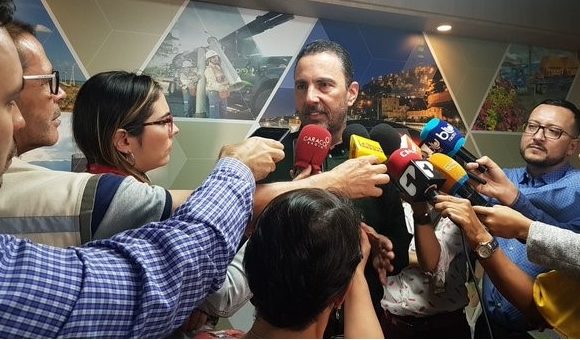Antioquia Will Continue to Dominate Gold Mining in Colombia: CGS Highlights

Antioquia Mining Secretary Dora Elena Balvin revealed at the 2018 edition of the annual Colombia Gold Symposium (CGS) here that Antioquia continues to dominate national gold production – and is likely to expand output dramatically in coming years.
One reason for optimism is the well-underway development of Continental Gold’s massive mining project at Buritica, Antioquia, as Continental chief financial officer Paul Begin told the 350 CGS delegates here in a November 13 presentation.
The high-tech, environmentally and socially responsible project – which has won high praise from the community as well as from local, departmental and national regulatory agencies — will become Colombia’s biggest gold mine when it hits full production in 2021, Begin explained.
Production at Buritica is now forecast at 300,000 ounces of gold per year, tapping reserves estimated at 3.86 million ounces, or 8.75 grams-equivalent of gold per ton of rock mined at the site.
Continental also foresees that its mining reserve here has a “global resource estimate of more than 9 million ounces” at 10.26 grams-equivalent per ton of rock mined.
Favorable geology, experienced leadership and high technology are seen delivering production costs at less-than US$600 per ounce of gold produced, with pre-production capital costs of US$475 million to US$515 million, he explained.
Construction at the project is now 38% complete. Global mining giant Newmont Mining recently took a 19.9% stake in Continental, investing C$109 million, while RK Mine Finance has put-up C$275 million in debt finance plus C$25 million in equity, he showed.
At year-end 2017, Antioquia’s gold production hit 634,655 ounces, or 46.4% of national production, Antioquia Mining Secretary Balvin explained here. Ten municipalities in Antioquia account for 92% of all production, she added.
What’s more, Antioquia now has an estimated gold reserve totaling more than 33 million ounces, with average production of 25 grams-equivalent per ton of rock mined, she explained.
Unique in all Colombia, the Antioquia departmental government administers mining regulations, including mining titles, oversight, programs to convert irregular and illegal miners to legalized mining, overseeing the abolition of toxic mercury used in gold processing, promotion of both local and international investment, and promotion of socially and environmentally responsible mining, she added.
Besides the Continental Project at Buritica, other proposed large-scale gold and copper-mining projects in Antioquia include AngloGold Ashanti’s currently stalled Gramalote and Quebradona projects, she noted.
The Gramalote project at San Roque, Antioquia, is estimated to have potential production of 350,000 to 450,000 ounces of gold per year, with a resource estimate over life-of-mine at 4.22 million ounces, she noted.
AngloGold has already invested US$270 million in the project, but local opposition to date has slowed development.
As for AngloGold’s proposed Quebradona copper-mine in Jericó, Antioquia, this project is in an “advanced stage” of studies to determine the extent and quality of the resource, which includes not only copper but also gold, silver and molybdenum, she said. AngloGold has already invested US$65 million in that proposed project, she added.
As for Medellin-based Mineros S.A., its “Ciénaga Grande” and “La Ye” projects in the municipalities of El Bagre, Zaragoza, Caucasia and Nechí, Antioquia, are in “advanced exploration stages,” according to Balvin.
“During 2017, Mineros allocated the sum of COP$46.5 billion pesos [US$14 million} in the advanced exploration stage, in support of its Colombia mining operations and support for [community-based] rubber plantations,” she said.
As for Gran Colombia Gold (GCG), which including predecessor company Frontino Gold Mines has been mining gold at Segovia, Antioquia for more than 150 years, its production continues apace, as noted in a separate presentation here by GCG exploration VP Alessandro Cecchi.
GCG, which has permanent offices in Toronto and in Medellin, produced 214,439 ounces of gold in the 12-month period from September 2017 to September 2018, Cecchi said. That’s a 23% boost in output over the comparable prior 12-month period, he added.
While Colombia generally and Antioquia specifically have suffered from decades of irresponsible and illegal mining by criminal groups and mercury-spewing miners, as well as mass anti-mining protests and strikes in certain communities, “today the panorama has changed [as more communites] approve mining,” Secretary Balvin said. However, instances of violence, murders and disorders still break-out, most recently in certain areas in Antioquia (see October 8, 2018 Medellin Herald, Continental Gold Honors Employees Murdered by FARC ‘Dissidents,’ Hires Top-Flight Security Agency).
In a separate presentation here, Agencia Nacional de Mineria (ANM) mining-promotion vice-president David Gonzales pointed-out that gold is 39% of all Colombian mining concessions, and Antioquia has more than two-thirds of the national gold concessions.
National gold production is expected to increase by 27% in 2020, he added.
Today, Colombia is 18th in global gold production, but fifth in Latin America. Colombia also is 42nd in global copper production, and sixth in Latin America, he said.
Gold-mining projects with already-approved environmental licenses here include Continental’s Buritica project, AngloGold Ashanti’s Gramalote project, Antioquia Gold’s Ciseneros project, and Alicant Mining’s Rionegro (Santander department) project, he said.
Other big upcoming gold-mining projects here include the Cordoba Minerals project at San Matias (Cordoba department), scheduled for 2023; Minesa’s “Soto Norte” project in Santander (currently tied-up in legal disputes over defining and controlling operations adjacent to or within the Santurban Paramo); the Miraflores Mining project at Miraflores, Risaralda, scheduled for 2021; the Batero Gold project at Batero-Quinchia, Risaralda, scheduled for 2023; the Orosur project at Anza, Antioquia, scheduled for 2021; and the Andes Resources project at Andes, Antioquia, scheduled for 2023, he said.
Colombia offers favorable incentives for mining including five-year amortization of assessments and exploration studies; tax refund certificates for miners that boost investments; public-works in-lieu of taxes; a 25% income-tax reduction for innovative R&D; discounts on sales taxes imposed on imported machinery; exemptions on payment and social-security taxes for lower-income employees; and a 25% income-tax deduction for environmental conservation measures, he said.
Obstacles Trip-Up Investment
Despite encouraging signs on several fronts, Colombia still puts-up obstacles to more-aggressive mining investment and development, as noted in a separate presentation here by Exploration Insights analyst Brent Cook.
While global demand for gold and copper continues to rise, “globally, discoveries are declining and odds [for success] are deteriorating,” Cook warned.
“Mining companies are increasingly desperate for new deposits, and Latin America is exceptionally prospective. Yet investment in exploration [here] is low, as perceived and real obstacles include political and bureaucratic problems, protests and lawsuits by non-governmental organizations, uncertainties about the rule of law, and security problems,’ he said.
“Mining investors’ money goes where it feels the investment is secure. And projects get advanced there,” he added.
In a panel discussion here featuring mining-legal experts Hernando Escobar, Hernan Rodriguez and Claudia Herrera, the panelists took note of seemingly contradictory legal decisions by Colombia’s Constitutional Court and the Council of State on whether local communities can block mining projects with “consultation” votes — even if a project had already been earlier approved by the national government.
The Court ruled on October 12 that “consultations” aren’t the correct legal method to stop mining, and that instead a new legal scheme must be developed by Congress to ensure proper coordination between national mining regulators, local governments and regional environmental agencies.
Ironically, one week after the Court decision, Colombia’s Council of State ruled in a separate lawsuit that it’s legal for mayors to invoke such consultations — but that the national government ultimately should decide whether to allow such mining.
Yet as legal expert Rodriguez pointed-out here, most members of Colombia’s Congress represent areas where mining doesn’t exist. So they likely wouldn’t have much interest in devoting time and energy for a new law governing mining regulation, he said.
While local communities have the responsibility to develop zoning laws (planes de ordenamiento territorial, or POTs), vast areas of Colombia lack updated POTs that otherwise potentially could trip-up or else encourage local mining applications presented to the national government.
Still, if more mining companies were more aggressive and thorough in carrying-out advanced consultations with local communities – including profound examinations of economic, social and environmental impacts of any proposed project – then perhaps some of the most angry protests and “consultations” against mining in certain areas might have been averted, he added.
However, “for now, the [mining] extractive sector and the [Colombian] government do not show signs of going beyond social corporate responsibility projects,” as local analysts at Colombia Risk Monthly noted in their November 2018 newsletter.
“Therefore, confrontation between proponents and opponents of projects [in certain areas] is likely in the near term both in the legislature and on the ground,” the analysts warned.
















